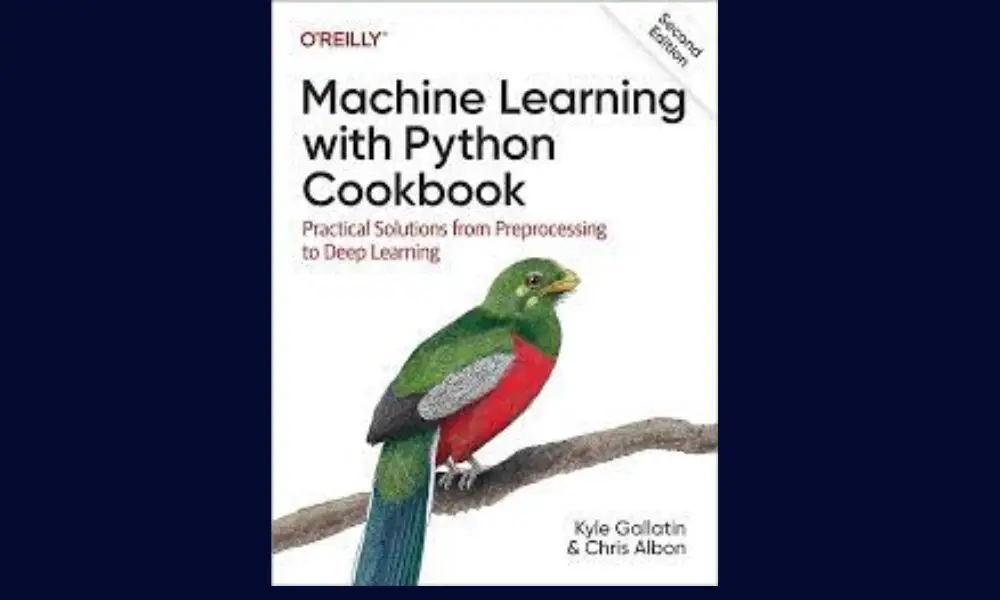Machine Learning with Python Cookbook: A Practical Solution from Preprocessing to Deep Learning by Chris Albon
Table of Contents
Introduction
In the ever-evolving world of machine learning, the book “Machine Learning with Python Cookbook: Practical Solutions from Preprocessing to Deep Learning” by Chris Albon stands as a valuable resource for practitioners seeking practical guidance in solving real-world machine learning challenges.
This review explores the book’s content, structure, and strengths, highlighting its significance in aiding professionals in their day-to-day machine-learning endeavours.
Book Summary
“Machine Learning with Python Cookbook” presents a collection of nearly 200 self-contained recipes that address a wide array of machine learning tasks.
Designed for individuals comfortable with Python and its libraries like pandas and sci-kit-learn, this book offers solutions to diverse problems, from data loading and preprocessing to model selection and dimensionality reduction.
The book’s approach goes beyond theory, offering hands-on code examples that readers can adapt to construct their applications.
Book Information
- Title: Machine Learning with Python Cookbook: Practical Solutions from Preprocessing to Deep Learning
- Author: Chris Albon
- Publisher: O’Reilly Media
- Publication Date: April 17, 2018
- Pages: 366 pages
- Formats: Paperback, Kindle
- Rating: 4.5 out of 5 stars (193 ratings)
Overview of the Book
The book follows a task-based approach, organized into self-contained recipes. It progresses from foundational concepts to more advanced techniques. Beginning with fundamental operations on arrays and data handling, it navigates through crucial steps like normalization, encoding, feature selection, and model evaluation. This logical progression allows readers to grasp essential concepts before delving into intricate machine-learning methods.
Key Concepts
Machine Learning with Python Cookbook” covers an extensive range of topics, including:
- Working with arrays, vectors, and matrices
- Handling numerical and categorical data, text, images, and dates
- Dimensionality reduction techniques
- Model evaluation and selection
- Regression, decision trees, k-nearest neighbours, SVMs, naive Bayes, clustering, and neural networks
- Saving and loading trained models
Writing Style and Clarity
Chris Albon’s writing style is pragmatic and accessible. He combines concise explanations with practical code examples, making complex concepts digestible.
His approach benefits both newcomers to machine learning and experienced practitioners seeking a quick reference for tackling specific challenges.
Strengths of the Book
The book’s strengths lie in its practicality and relevance to real-world scenarios. Each recipe includes a working code that readers can adapt, fostering a hands-on learning experience.
The comprehensive coverage of tasks, along with meaningful discussions, provides valuable insights for readers at all skill levels. Additionally, the book’s approach to providing working solutions complements traditional theoretical resources.
Areas for Improvement
While the book excels in practicality, some readers might appreciate deeper theoretical explanations in certain areas. Including more visual aids, such as diagrams or illustrations, could enhance the book’s accessibility and comprehension of complex concepts.
Who Should Read This Book
““Machine Learning with Python Cookbook” caters to a specific audience: those who are comfortable with the basics of machine learning and Python programming but seek practical solutions for day-to-day challenges. It’s ideal for data scientists, machine learning engineers, and professionals who want a quick reference guide to tackle real-world problems effectively.
Conclusion
“Machine Learning with Python Cookbook” serves as an invaluable companion for machine learning practitioners seeking practical solutions. Chris Albon’s approach bridges the gap between theory and implementation, providing actionable insights that empower readers to confidently address complex machine learning tasks. This book equips readers with the tools to navigate the intricacies of machine learning and make impactful contributions to their projects.
FAQ
Is this book suitable for beginners in machine learning?
This book is better suited for individuals with a foundational understanding of machine learning and Python programming. It caters to those who want practical solutions for real-world challenges.
Does the book include practical examples and code?
Yes, each recipe includes code snippets that can be copied, pasted, and adapted. This approach helps readers understand and apply concepts quickly.
Are there visual aids to aid comprehension?
While the book provides explanations and code, it could benefit from more visual aids to enhance the understanding of complex concepts.
Does the book cover advanced machine-learning techniques?
Yes, the book covers a wide range of techniques, from fundamental concepts to advanced models like neural networks and clustering.
Can beginners benefit from this book?
While beginners can gain insights, this book is more suited for those who already possess foundational knowledge of machine learning and Python programming.
